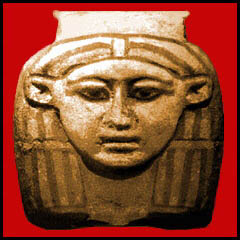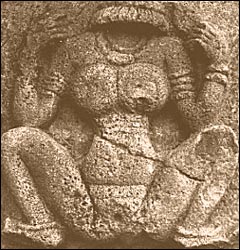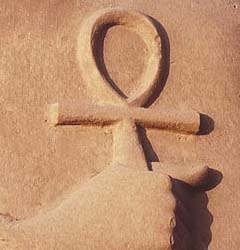Hathor, The Divine "Flasher"

|
The Sun-God and the Stripper Ra, the Sun-god was presiding over the Court of the Gods in the case of young Horus vs. his Uncle Set, in the matter of the inheritance of kingship of Egypt from the princeling's late father Osiris. The Court was about to grant Horus' petition and announce him King, when Ra disclosed his prejudice in favor of Set. Following a temporary suspension of the divine proceedings Ra seemed ready to decide the case in favor of the boy's wicked uncle.At this point the god Babai arose and insulted the great Ra, mocking him with the words: "Thy shrine is empty!" Angered at Babai's impudent challenge to his dispensation of justice, Ra vacated his post, reclined on his back, and totally disrupted the proceedings.
The next day, Ra still lay upon his back ignoring everyone when his daughter Hathor, the Lady of the Sycamore
Fig Tree, came into the court of his house and decided to attract his attention away from this angry sulking.
Without any preliminaries she stripped off her clothing and exhibited her nude body to Ra. And, to make sure she
had fully distracted the King of the Gods, Hathor exposed her vulva in front of his face and remained there until
she got a response.
--==( O )==--
|
|
Comments on Hathor the Flasher
In this story the divine order has yet to be properly set in place. Only after Horus finally takes his rightful place as the demigod king of a united Egypt can life on earth continue as it was meant to. Most of the obstacles in Horus' path to this rightful end are placed there by the nemesis figure of Set, the fiery god of masculine passions and desert desolation. On the other hand, most of these obstacles are removed or overcome by the divine intervention of protective goddesses such as Isis and Hathor, exercising their compensating powers of feminine wisdom and fertility. In this story, not only is the earthly order in disarray, the heavenly order has also broken down and Ra must be restored to his correct duties as king of the gods. Ra's surly inactivity has placed the entire cosmos in a very dangerous situation and the remedy calls for some powerful feminine intervention.
--==( O )==--
Another Hathor authority, Geraldine Pinch, sees Hathor's display as one whereby "the Sun God is sexually aroused." According to Pinch, Ra's arousal "banishes the negative and restores his positive aspect." It is true that Hathor was called The Lady of the Vulva and that her role in providing the sexual attraction which brought lovers together was central to her divine nature as the Goddess of Fertility and Childbirth. However, in the "flasher" story Hathor is pictured as the daughter of Ra and there is no indication that any sexual activity took place between celestial parent and child. If the sight of Hathor's vulva aroused Ra, it was not the arousal of the contemporary viewer of Penthouse and Hustler magazine photos, much less that of the furtive kiddy porn addict. Something is still missing from our analysis of the story thus far.
The magical vagina was symbolized in ancient Egypt as the "Sa sign" a closed oval loop which looks rather like the handle of the ankh cross. This sign of protection and benevolent power was modeled on a papyrus shelter, a fact which recalls Hathor's aspect as a wild marsh cow who protects the unborn Horus in her womb. The private parts of both sexes were thought to have powerful effects even over a considerable distance. Perhaps Hathor was displaying a living Sa sign to ward off the evil influences which Set had brought into Ra's presence.
While the story of Hathor the flasher is open to many explanations, its real interpretation is likely to be found in the mythology surrounding her role in the birth of the Sun God and in the preservation of a balance between his masculine powers and her feminine influences. As a piece of mythology the display scene is rooted in cyclical divine processes moreso than in any single event from cosmic or earthly history. Rather than attempting to isolate such an event and to apply some specific meaning to Hathor's genital display, modern readers would do better to allow themselves some visualization or feeling of the spiritual truths which underlie the story's symbolism.
--==( O )==--
Today we can do little to recapture the experiences of Hathor's devotees. If some of her dances and plays included erotic displays, we can little appreciate what such things meant to her devout worshippers in ancient times. Perhaps a bit of appreciation for the powers of goddesses such as Hathor lingers on in Hinduism and a few other religions, but not much remains in the scientific humanism of modern times. Hopefully, however, we can still identify with the wonder of sexual attraction, feelings of awe at the birth of a child, and an appreciation for a compassionate divinity who will turn her face to hear our innermost thoughts and prayers. Commentary by Dale Broadhurst |
return to top of page
The Sistrum in the Sinai | Hathor Home Page | Dale R. Broadhurst Home Page
last updated: Nov. 15, 2005

